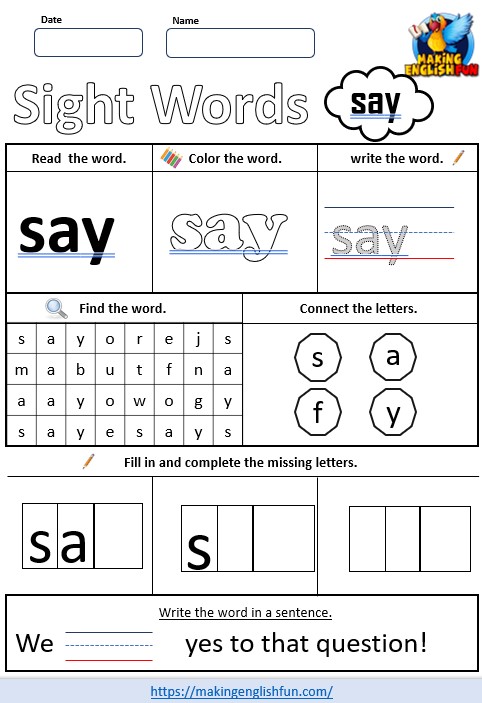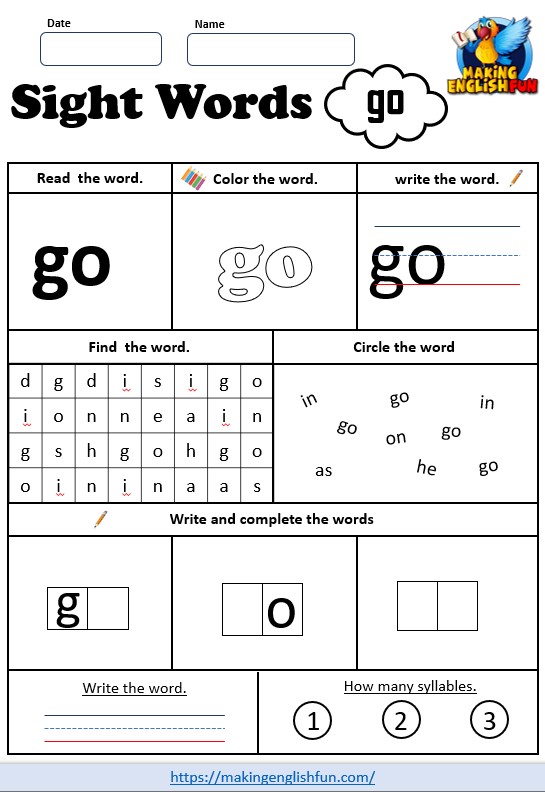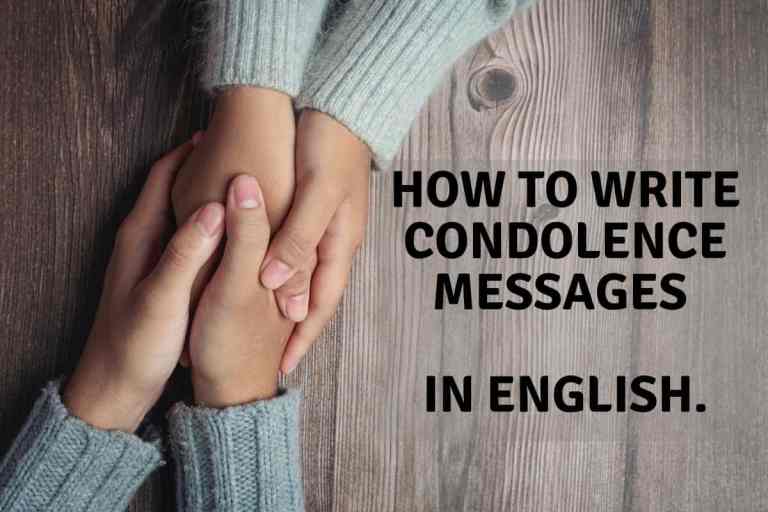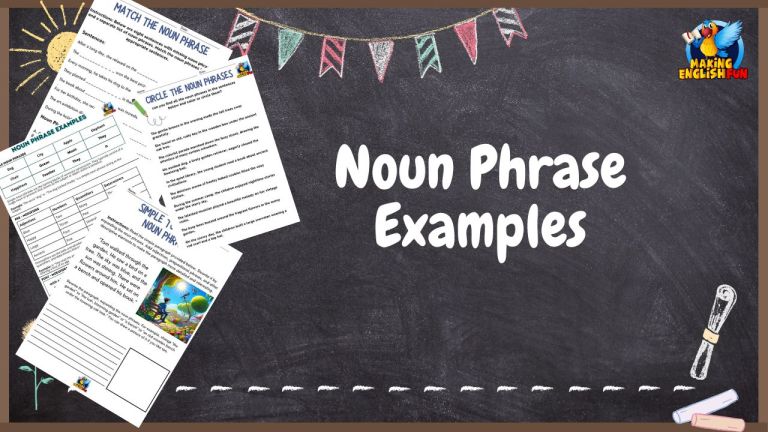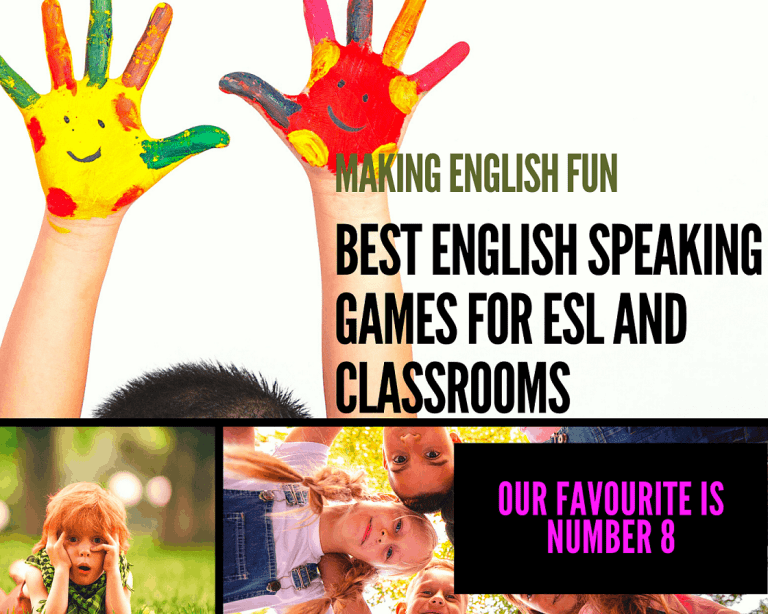25 Sight Word Games
Welcome to the world of early reading and literacy! Whether you’re a parent guiding your child’s first steps into reading or an educator looking for fresh ideas, you’ve come to the right place.
In this guide, we’ll explore over 25 sight word games and activities – those commonly used words that young readers should, with practice, recognize instantly.
But we won’t just talk about them; we’ll dive into a treasure trove of activities to make learning these words not only effective but also incredibly fun!
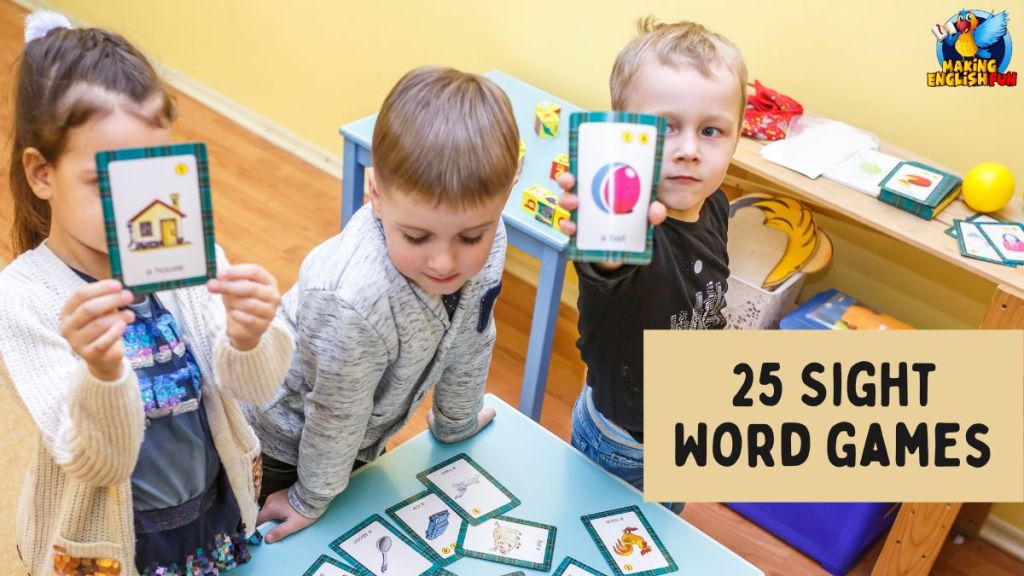
Understanding Sight Words
Before we jump into the activities, let’s set the stage by understanding what sight words are.
Sight words, often referred to as high-frequency words, are words that appear frequently in English texts.
They’re the building blocks of early reading. Some of these words follow standard phonetic rules, while others are a bit irregular – making them tricky for young learners to decode using standard phonics techniques.
That’s where the magic of sight word recognition comes in. It’s about getting children to recognize these words by sight, which helps in building reading speed and fluency.
we have more information on what sight words are in the article below if you need.
The Importance of Engaging Activities in Learning Sight Words
So, why focus on activities?
Learning sight words isn’t just about memorization; it’s about making connections and understanding the context.
Engaging, hands-on activities cater to various learning styles – whether your child is a visual, auditory, or kinesthetic learner.
These activities not only reinforce word recognition but also make the learning process joyful and memorable.
When children enjoy what they’re doing, they’re more likely to engage, absorb, and retain information.
Plus, interactive activities provide a wonderful opportunity for bonding, whether in a classroom setting or at home.

25 Sight Word Games for Homes and Classrooms
Activity 1: Sight Word Bingo
Quick Facts:
| How to Play | Duration | Equipment Needed | Age Range |
|---|---|---|---|
| Players match sight words on their bingo cards with words called out. First to complete a row shouts ‘Bingo!’ | 10-15 minutes | Bingo cards with sight words, caller cards, markers/counters | 4-8 years |
Description:
Sight Word Bingo is an exciting game for reinforcing word recognition. Prepare bingo cards with a selection of sight words and a set of caller cards. Players mark their cards when a called word matches.
The first to complete a row wins. It’s ideal for group settings, fostering quick recognition and engagement. Tailor the word difficulty to suit the age group.
Activity 2: Flashcard Fun
Quick Facts:
| How to Play | Duration | Equipment Needed | Age Range |
|---|---|---|---|
| Show sight word flashcards to the child, who reads each word aloud. Introduce games like guessing the word or finding pairs. | 5-10 minutes per session | Sight word flashcards | 4-7 years |
Description:
Flashcard Fun is a flexible and effective way to reinforce sight words. Start by showing each card to the child, encouraging them to read the word aloud.
As they become more comfortable, introduce variations like timed challenges or guessing games. For a more interactive experience, play a matching game by laying cards face down and finding pairs. T
Activity 3: Sight Word Treasure Hunt
Quick Facts:
| How to Play | Duration | Equipment Needed | Age Range |
|---|---|---|---|
| Hide sight word cards around a room or outdoor area. Kids find and read each word. | 15-20 minutes | Sight word cards | 5-8 years |
Description:
The Sight Word Treasure Hunt is an adventurous way to learn. Hide cards around a room or garden and let the kids hunt for them.
Each found card becomes a small victory as they read the word aloud.
Activity 4: Arts and Crafts with Sight Words
Quick Facts:
| How to Play | Duration | Equipment Needed | Age Range |
|---|---|---|---|
| Incorporate sight words into arts and crafts projects, like making word collages or decorating words. | 20-30 minutes | Craft supplies, sight word printouts | 4-8 years |
Description:
Arts and Crafts with Sight Words merge creativity with learning. Children use sight word printouts in various art projects – creating collages, decorating the words with glitter and paint, or even constructing word mobiles.
This artistic approach engages children’s creative skills and helps in embedding sight words in their memory through a multi-sensory experience.
It’s particularly effective for visual and tactile learners, providing a colorful and hands-on way to learn.

Activity 5: Sight Word Worksheets
Quick Facts:
| How to Play | Duration | Equipment Needed | Age Range |
|---|---|---|---|
| Children complete worksheets that involve identifying, tracing, or matching sight words. | 10-15 minutes per worksheet | Sight word worksheets, pencils | 4-7 years |
Description:
Sight Word Worksheets offer a more traditional, structured approach to learning sight words. These worksheets can vary from tracing and writing sight words to word searches or matching exercises.
They’re excellent for reinforcing word recognition, spelling, and writing skills. Worksheets can be tailored to individual learning levels, making them a valuable tool for both classroom instruction and home practice.
You can access our free sight word worksheets below.
- Sight Word Spelling Worksheets
- 25 Sight Word kindergarten Worksheets
- Sight Word Worksheets 1 -20
- Sight words worksheets 21-40
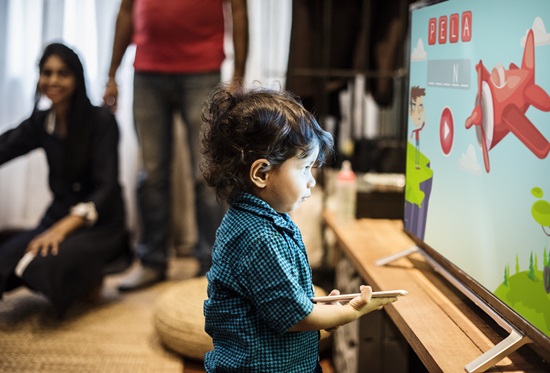
Activity 6: Online Sight Word Games
Quick Facts:
| How to Play | Duration | Equipment Needed | Age Range |
|---|---|---|---|
| Children play interactive games that involve reading and selecting sight words. | Varies | Computer or tablet with internet access | 4-8 years |
Description:
Online Sight Word Games blend technology with learning, offering an interactive and engaging way for children to practice sight words.
These games often include colorful graphics, sounds, and rewards, making them highly appealing to young learners.
From simple word recognition to more complex spelling challenges, these games adapt to various skill levels.
We have the best online sight word games linked below!
Activity 7: Sight Word Fishing
Quick Facts:
| How to Play | Duration | Equipment Needed | Age Range |
|---|---|---|---|
| Use a fishing rod with a magnet to ‘catch’ paper fish with sight words written on them. | 15-20 minutes | Fishing rod with magnet, paper fish with words, paper clips | 4-7 years |
Description:
Sight Word Fishing is a captivating and interactive way to learn. Kids use a makeshift fishing rod with a magnet to ‘catch’ paper fish that have sight words on them.
Each ‘catch’ is an opportunity to read a new word. This game not only aids in word recognition but also helps develop fine motor skills and hand-eye coordination.
Activity 8: Sight Word Memory Match
Quick Facts:
| How to Play | Duration | Equipment Needed | Age Range |
|---|---|---|---|
| Create a memory card game with pairs of sight words. Children flip cards to find matching pairs. | 10-15 minutes | Sight word cards or homemade memory cards | 4-7 years |
Description:
Sight Word Memory Match is a classic memory game with a literacy twist. Each pair of cards has the same sight word, and the goal is to find matching pairs.
This game enhances both memory and word recognition skills. It’s a quiet, focused activity that can be played individually or in small groups, perfect for classroom centers or quiet time at home.
Activity 9: Sight Word Hopscotch
Quick Facts:
| How to Play | Duration | Equipment Needed | Age Range |
|---|---|---|---|
| Write sight words in hopscotch squares. Children say the word as they land on each square. | 15-20 minutes | Chalk or tape, open space | 5-8 years |
Description:
Sight Word Hopscotch combines physical activity with learning. Write sight words on the ground using chalk or tape.
As children hop along the squares, they read each word aloud. It’s an excellent way to incorporate movement into learning, especially beneficial for kinesthetic learners.
Activity 10: Sight Word Balloon Pop
Quick Facts:
| How to Play | Duration | Equipment Needed | Age Range |
|---|---|---|---|
| Write words on balloons. Children pop them and read the word. | 10-15 minutes | Balloons, marker, safety pin or small stick | 4-7 years |
Description:
Sight Word Balloon Pop is an exciting and dynamic activity. Each balloon has a sight word written on it.
When a balloon is popped, the child reads the word.
This activity is great for parties or group settings, adding a sense of excitement and anticipation.
Activity 11: Sight Word Hide and Seek
Quick Facts:
| How to Play | Duration | Equipment Needed | Age Range |
|---|---|---|---|
| Hide sight word cards in various places. Children seek the cards and read each word they find. | 15-20 minutes | Sight word cards | 5-8 years |
Description:
Sight Word Hide and Seek is a delightful twist on the classic game.
Hide cards with sight words around the room or outdoors. As children find each card, they read the word aloud.
This activity not only reinforces word recognition but also adds an element of surprise and exploration, keeping the learning experience fresh and engaging.
Activity 12: Sight Word Story Creation
Quick Facts:
| How to Play | Duration | Equipment Needed | Age Range |
|---|---|---|---|
| Kids use a selection of sight words to create a short story or sentences. | 20-30 minutes | Sight word cards, paper, pencil | 6-9 years |
Description:
Sight Word Story Creation encourages creativity and application. Children select sight words and weave them into a story or sentences.
This activity not only practices word recognition but also enhances creative thinking and writing skills.
Activity 13: Sight Word Puzzles
Quick Facts:
| How to Play | Duration | Equipment Needed | Age Range |
|---|---|---|---|
| Create puzzles where matching pieces form a sight word. Children solve the puzzles to read the words. | 10-20 minutes | Puzzle templates or homemade puzzles | 4-7 years |
Description:
Sight Word Puzzles are an engaging way to learn. Each puzzle piece has a part of a sight word, and the goal is to piece them together to form the complete word.
This activity combines cognitive skills like problem-solving and word recognition.
Activity 14: Sight Word Musical Chairs
Quick Facts:
| How to Play | Duration | Equipment Needed | Age Range |
|---|---|---|---|
| Place sight word cards on chairs. As music plays, children walk around. When music stops, they find a chair and read the word. | 15-20 minutes | Chairs, sight word cards, music player | 5-8 years |
Description:
Sight Word Musical Chairs adds a literary spin to this classic game. Each chair has a sight word card.
As the music plays, children circle the chairs. When the music stops, each child finds a chair and reads the sight word aloud.
Activity 15: Sight Word Stamping
Quick Facts:
| How to Play | Duration | Equipment Needed | Age Range |
|---|---|---|---|
| Kids use stamps to create art with sight words, stamping them on paper in creative patterns or designs. | 20-30 minutes | Alphabet stamps, ink pads, paper | 4-7 years |
Description:
Sight Word Stamping allows children to engage in artistic expression while learning.
Using alphabet stamps, children stamp sight words onto paper, creating patterns, shapes, or even short sentences.
This activity is particularly appealing to tactile learners and offers a unique way to reinforce word recognition while tapping into creative skills.
Activity 16: Sight Word Wall
Quick Facts:
| How to Play | Duration | Equipment Needed | Age Range |
|---|---|---|---|
| Create a wall or board where sight words are displayed and regularly updated. Children interact with the wall, reading and adding new words. | Ongoing | Wall space or bulletin board, sight word cards | 4-8 years |
Description:
A Sight Word Wall is a dynamic and interactive learning tool. It serves as a visual reminder of the words learned and provides a space for children to engage with new words.
Regularly adding new sight words turns this into an evolving project, encouraging frequent interaction and review.
Activity 17: Sight Word Bean Bag Toss
Quick Facts:
| How to Play | Duration | Equipment Needed | Age Range |
|---|---|---|---|
| Toss bean bags onto sight word cards spread on the ground. Read the word where the bag lands. | 15-20 minutes | Bean bags, sight word cards | 5-8 years |
Description:
Sight Word Bean Bag Toss is an active and enjoyable way to learn sight words. Spread sight word cards on the ground and have children toss bean bags onto them.
Each landing prompts the child to read the word hit and of course you can keep a running score.
Activity 18: Sight Word Races
Quick Facts:
| How to Play | Duration | Equipment Needed | Age Range |
|---|---|---|---|
| Set up relay races where children run to a point, read a sight word, and return. | 15-25 minutes | Sight word cards, open space | 5-9 years |
Description:
Sight Word Races are a fantastic way to combine physical activity with sight word practice.
Set up a course where children race to a point, pick a sight word card, read it aloud, and race back. .
Activity 19: Sight Word Building Blocks
Quick Facts:
| How to Play | Duration | Equipment Needed | Age Range |
|---|---|---|---|
| Write sight words on building blocks. Children build structures and read words as they play. | 20-30 minutes | Building blocks, marker | 4-7 years |
Description:
Sight Word Building Blocks turn playtime into learning time.
By writing sight words on the sides of building blocks, children encounter and read these words as they construct.
Activity 20: Sight Word Flashlight Find
Quick Facts:
| How to Play | Duration | Equipment Needed | Age Range |
|---|---|---|---|
| Turn off lights and use a flashlight to find and read sight words on the wall or scattered around the room. | 15-20 minutes | Flashlights, sight word cards or printouts | 5-8 years |
Description:
Sight Word Flashlight Find turns learning into an exciting adventure. In a dimly lit room, children use flashlights to discover sight words placed around the space.
Each word they find and read adds to the thrill. This activity is perfect for engaging children’s senses and making reading a fun, exploratory experience.
Activity 21: Sight Word Word Search
Quick Facts:
| How to Play | Duration | Equipment Needed | Age Range |
|---|---|---|---|
| Children complete word search puzzles featuring sight words. | 10-15 minutes per puzzle | Word search puzzles with sight words | 6-9 years |
Description:
Sight Word Word Search is a classic puzzle that challenges children to find and circle sight words hidden in a grid of letters.
This activity helps reinforce word recognition and spelling while also enhancing focus and concentration. It’s a great worksheet activity for individual or quiet group work.
Activity 22: Sight Word Sentence Building
Quick Facts:
| How to Play | Duration | Equipment Needed | Age Range |
|---|---|---|---|
| Kids use sight word cards to build and read sentences. | 20-30 minutes | Sight word cards, paper for writing sentences | 6-9 years |
Description:
Sight Word Sentence Building encourages children to use sight words in context.
They create sentences using a selection of sight word cards, laying them out in order and reading them aloud.
This activity not only reinforces word recognition but also aids in understanding sentence structure and the practical use of words in communication.
Activity 23: Sight Word Dominoes
Quick Facts:
| How to Play | Duration | Equipment Needed | Age Range |
|---|---|---|---|
| Create dominoes with sight words instead of numbers. Match words to play. | 15-20 minutes | Sight word dominoes (homemade or purchased) | 5-8 years |
Description:
Sight Word Dominoes is a twist on the traditional game, using words instead of dots.
Children match sight words on the dominoes, connecting them end-to-end.
This game is excellent for group play and helps in developing strategic thinking and word recognition skills in an engaging, playful setting.
Activity 24: Sight Word Snack Time
Quick Facts:
| How to Play | Duration | Equipment Needed | Age Range |
|---|---|---|---|
| Use alphabet-shaped snacks to spell out and eat sight words. | 15-20 minutes | Alphabet-shaped snacks | 4-7 years |
Description:
Sight Word Snack Time combines learning with a tasty treat. Using alphabet-shaped snacks, children spell out sight words before enjoying their edible creations.
This activity is a delightful way to make learning interactive and delicious, perfect for engaging younger children in a sensory learning experience.
Activity 25: Sight Word Jigsaw Puzzle
Quick Facts:
| How to Play | Duration | Equipment Needed | Age Range |
|---|---|---|---|
| Create jigsaw puzzles with sight words. Children assemble the puzzle to form words. | 15-20 minutes | Sight word jigsaw puzzles (homemade or purchased) | 5-8 years |
Description:
Sight Word Jigsaw Puzzle adds a layer of complexity to word recognition. Each puzzle piece features a part of a sight word, and the challenge is to assemble the pieces correctly to form the word.
This activity enhances spatial awareness, problem-solving skills, and word recognition, making it an engaging and educational experience.
Incorporating Sight Word Activities in Daily Routines
While dedicated activities are fantastic, integrating sight word learning into daily routines can be equally effective.
This approach ensures that children are frequently exposed to these words, helping to reinforce their learning.
Here are a few ideas:
- Labeling Household Items: Label common items around the house with sight words. This not only helps in word recognition but also in associating words with their meanings.
- Sight Word of the Day: Introduce a ‘sight word of the day’ and encourage its use in conversations. This can be a fun way to bring new words into everyday use.
- Story Time: During story reading, point out sight words in the text. This helps children recognize these words in the context of a story.
- Sight Word Songs: Create or find songs that include sight words. Singing is a delightful way to remember words and their sounds.
Conclusion
Sight words are a foundational element in developing reading skills, and learning them doesn’t have to be a chore.
With a variety of activities ranging from games to artistic projects, you can turn sight word practice into an enjoyable and rewarding experience for young learners.
Remember, the key is to keep the activities fun and engaging, catering to different learning styles and interests.
By regularly incorporating these activities into learning routines, you’ll help children build a strong foundation for reading success.
https://makingenglishfun.com/2021/11/11/is-there-an-order-to-teach-sight-words/







